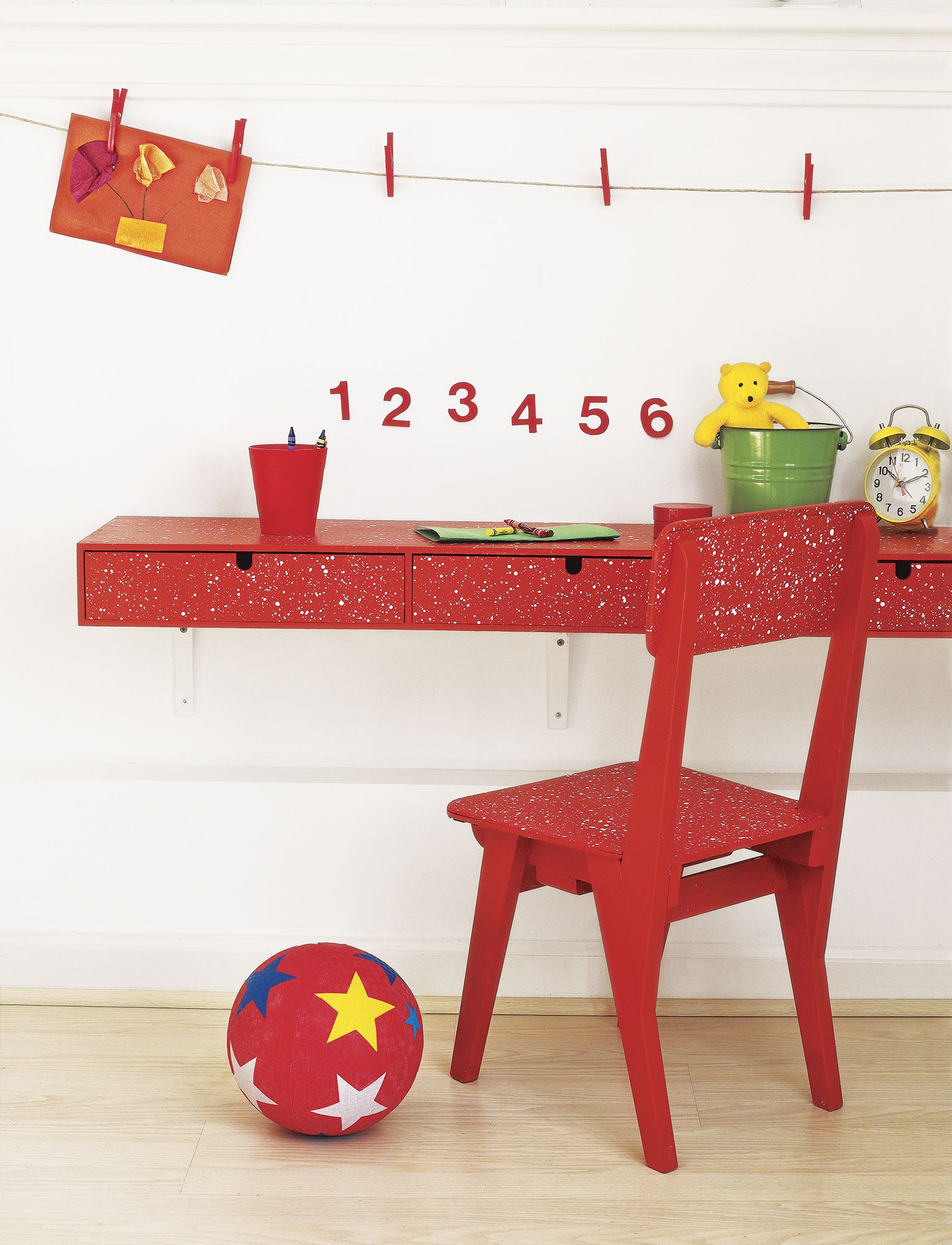 Nylon-polyester paint brush – 3-inch
Nylon-polyester paint brush – 3-inch Cut bucket and liners
Cut bucket and liners Safety goggles
Safety goggles Gloves
Gloves Painter’s tape
Painter’s tape
We may be compensated if you purchase through links on our website. Our team is committed to delivering honest, objective, and independent reviews on home products and services.
Looking to liven up an old or plain furniture piece? As artist Ingrid Leess says, “Spattering is an easy way to revive a blah piece of furniture and give it a custom touch.” To practice this fun painting technique, you flick or spatter paint onto a canvas, dresser, or other surface to create a speckled pattern. In our article, we’ll share a step-by-step guide on how to create paint-spattered furniture, troubleshoot some common issues, and maintain your paint-spattered finished piece.
Benefits of Paint-Spattering Furniture
There are several advantages to paint-spattering for do-it-yourself (DIY) enthusiasts and home decorators, which include the following:
- Affordability: You can change home decor without having to buy a new furniture piece.
- Customization: This painting technique allows you to create one-of-a-kind pieces that match your style.
- Ease of application: This is an easy DIY project for anyone regardless of their artistic skill or experience.
- Quick results: Paint-spattering is fast, so it won’t take you long to create a unique piece.
- Versatility: You can paint-spatter furniture types and styles.
The Tools and Materials You’ll Need for Paint Spattering Furniture
Before you start your paint-spattering project, collect all the supplies and tools you need. This will help you stay organized and make the process move faster.
Brushes and Application Tools
You’ll need the following tools for your paint-spattering project:
- Mixing containers for paint and glaze
- Nylon-polyester paintbrush (3-inch) for applying the base coat
- Spatter brush or toothbrush for creating paint flecks
- Stirring sticks
Protective Equipment
Remember to gather your safety equipment to cover yourself and the space. You’ll need the following items:
- Drop cloths or plastic sheeting
- Gloves
- Old clothes or a paint smock
- Painter’s tape
- Safety goggles
Paint and Glaze Selection
Once you’ve chosen the colors you want to use, you need a satin latex for the base coat. For the spatter coat, mix equal parts satin latex paint (in a contrasting color) and clear acrylic glaze. You can use the glaze to add shine and dimension to the speckles.
Paint: Behr’s red hot (base coat) and snow fall (glaze coat)
Step 1: Preparing Your Furniture for Paint-Spattering
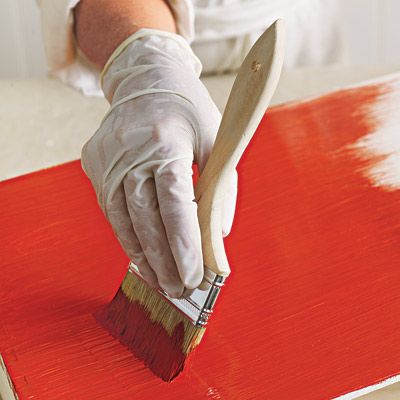
Now that you have your tools, you have to prepare the furniture piece, which includes cleaning, priming, and applying a base coat.
Cleaning and Priming the Surface
Thoroughly clean the piece to remove any dirt, dust, or grease. If it’s already painted, sand it first so that the new paint layer adheres to it well. You can apply a layer of primer if the surface is unpainted or raw wood.
Applying the Base Coat
After you’ve cleaned and primed the furniture, you can add the base coat. Use a nylon-polyester paintbrush to apply the satin latex paint. To make sure you spread the paint evenly and smoothly, work along the length of the piece. Let the first coat dry, then apply a second coat for full coverage.
Step 2: Mixing Paint and Glaze
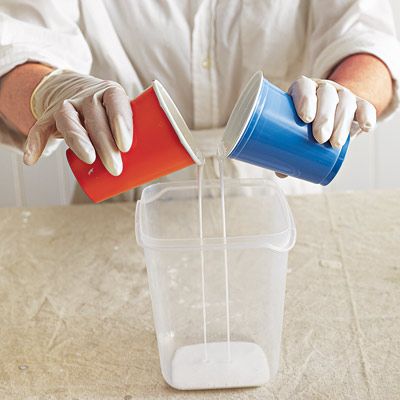
Combine equal parts of clear acrylic glaze and your chosen top-coat color in a wide-mouth mixing container. Stir the mixture until it’s creamy and luminous.
Step 3: Mastering the Spattering Technique
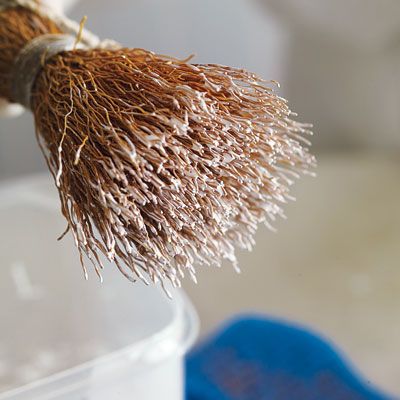
If you’re new to spattering, you can practice on a piece of cardboard before you take the brush to your furniture. Whether you’re diving right in or giving it a try on cardboard, follow these steps:
- Dip just the bristle tips of your spatter brush into the paint-glaze mixture.
- Hold a stick or ruler about 6 inches above the furniture surface.
- Lightly tap the loaded brush against the stick so that paint flecks fall onto the surface.
- Maintain a consistent rhythm and pressure as you work across the entire surface.
Advanced Paint-Spattering Techniques
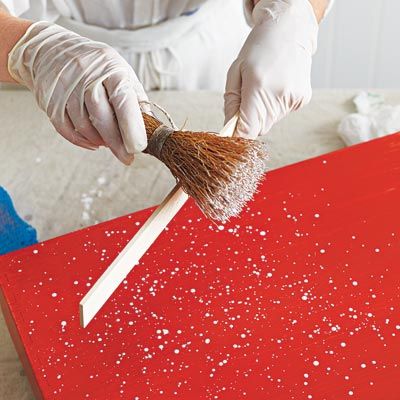
Paint-spattering is a simple DIY project, but you can take it to the next level after you have a bit of practice behind you. Consider the following methods to create and customize your furniture.
Creating Different Spatter Effects
You can play around with distance and brush pressure for different effects by:
- Adjusting the force of your tapping for different spatter sizes and densities
- Moving closer to the surface for larger spatters
- Stepping further away for smaller, more delicate speckles
Layering Multiple Colors
Layering colors will give your piece depth and visual interest. Start with a lighter shade and gradually build up to darker hues. Be sure to let each layer dry before applying the next one.
Combining Spattering With Other Painting Methods
You can combine different painting techniques to really make your new furniture design shine and reflect your style and personality. Here are a few ideas:
- Color blocking
- Distressing
- Ombre effects
- Stenciling
Finishing and Protecting Your Paint-Spattered Furniture
Whether you decide to do a simple paint-spattering or use a more advanced technique or combination, there are two ways to finish and protect your newly painted piece.
Allowing Proper Drying Time
Let each surface dry before you use the furniture. Otherwise, the paint will be tacky, and you’ll ruin the finish. It usually takes about 24 hours to dry, but this depends on humidity and the temperature.
Applying a Protective Sealant
Protect your paint job by applying a clear protective sealant once the paint is fully dry. Find a water-based polyurethane for a durable finish that won’t yellow over time. Follow the manufacturer’s instructions, which will most likely recommend that you use a foam brush or sprayer for even coverage.
Troubleshooting Common Paint-Spattering Issues
Even the most experienced DIYer can run into a problem. Here are some common issues and how to address them.
Fixing Uneven Spatter Distribution
Sometimes you’ll find that an area either has too little or too much spatter. If that’s the case, you can make these adjustments:
- For overly dense areas, wipe away excess spatter with a damp cloth while the paint is still wet.
- For sparse spots, add more spatter by focusing on those sections during a second pass.
Dealing with Unwanted Large Drops
You may not want larger drops of paint. To fix unwanted blobs, do the following:
- Quickly blot the large drop with a paper towel or cloth to remove excess paint.
- Use a small brush to blend the edges of the drop into the surrounding spatter pattern.
Creative Ideas for Paint-Spattered Furniture Projects
If you like the idea of creating a paint-spatter piece but aren’t sure what you can apply this technique to, here are a few ideas to inspire your next project.
- Enhance outdoor furniture: Paint-spattering isn’t just for your indoor pieces. You can do it to picnic tables, benches, or garden chairs for an eclectic outdoor look. Be sure to use weather-resistant paints and sealants to ensure your creations withstand the elements.
- Making a statement with coffee tables: Coffee tables are often the centerpiece of a living room. Paint-spatter the tabletop for a striking touch or cover the whole thing to turn an ordinary table into a conversation starter.
- Personalize bedroom furniture: Consider using this technique on a nightstand or dresser. Opt for bright, playful colors in a child’s bedroom or a more subdued palette in your space.
- Revamp old wooden chairs: Make plain wooden chairs into eye-catching accent pieces that match your room’s decor. You can spatter just the seat or backrest or go bold by covering the entire chair.
- Transform plain bookshelves: Add a pop of color to a boring bookshelf by paint-spattering the back panels or shelves.
Maintaining Your Paint-Spattered Furniture
Maintaining your paint-spattered furniture will make it look great for years to come. Below are some tips to keep your pieces in top condition.
Cleaning Tips for Longevity
Do the following to clean your paint-spattered furniture:
- Avoid harsh chemicals or abrasive cleaners that could damage the finish.
- Dust regularly with a soft, dry cloth.
- For tougher dirt, use a slightly damp cloth with mild soap.
Touch-Up Techniques
If your paint-spattered finish becomes scratched or worn over time, you can touch it up by doing the following:
- Blending the new spatter with the existing pattern for a seamless repair
- Mixing a small amount of the original paint-glaze mixture
- Using a small brush to apply spatter to the affected area
